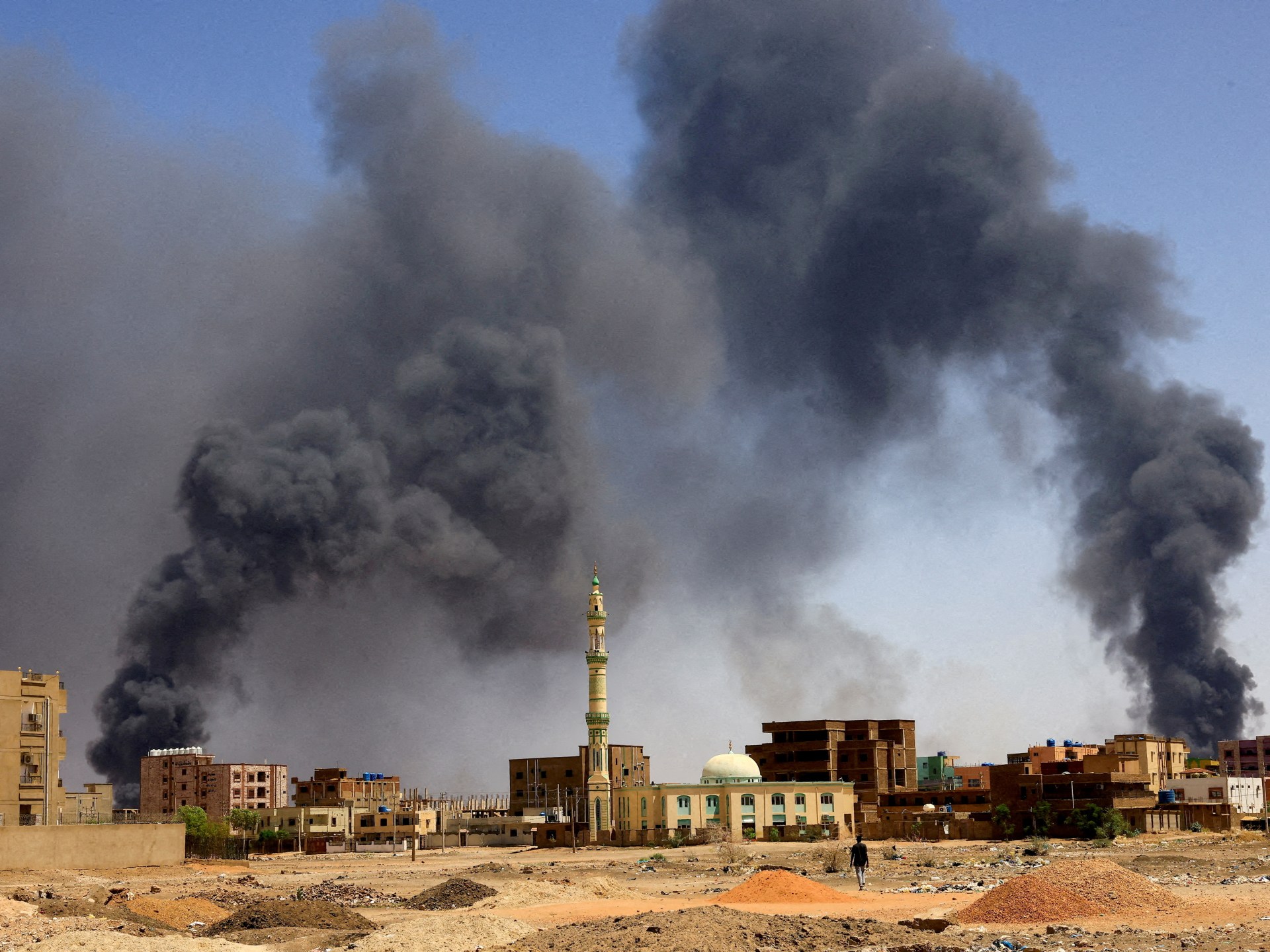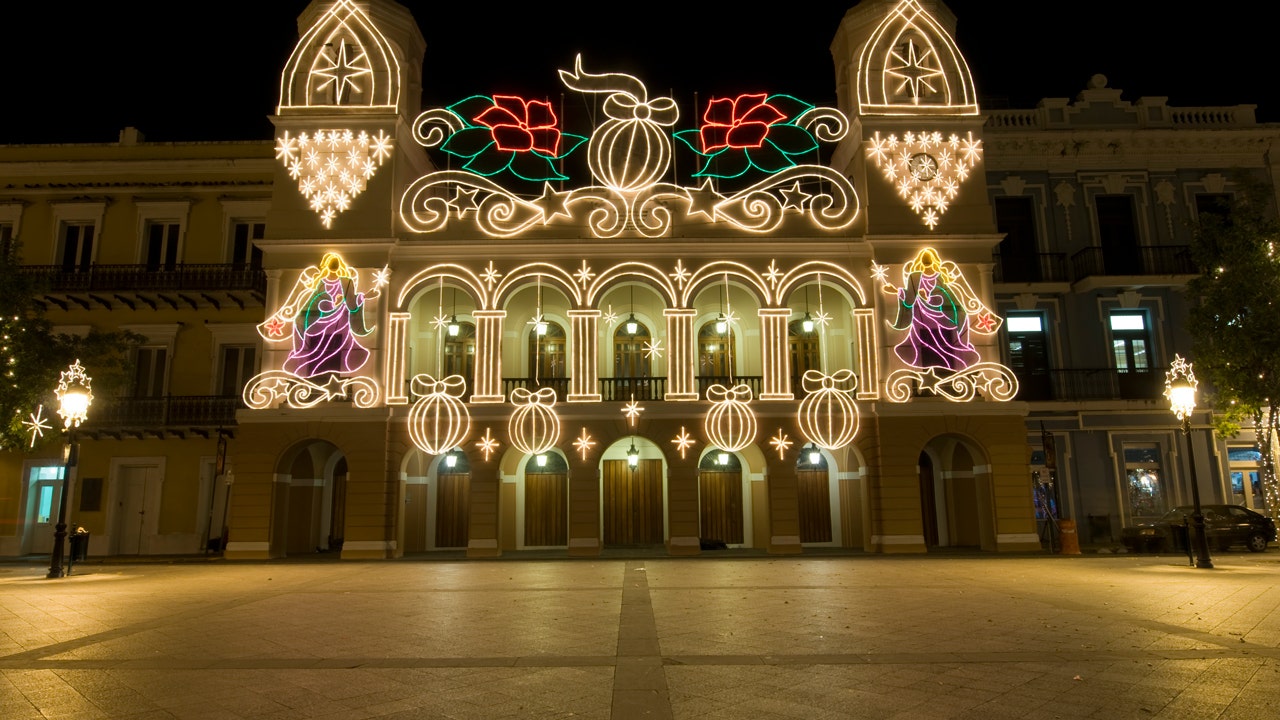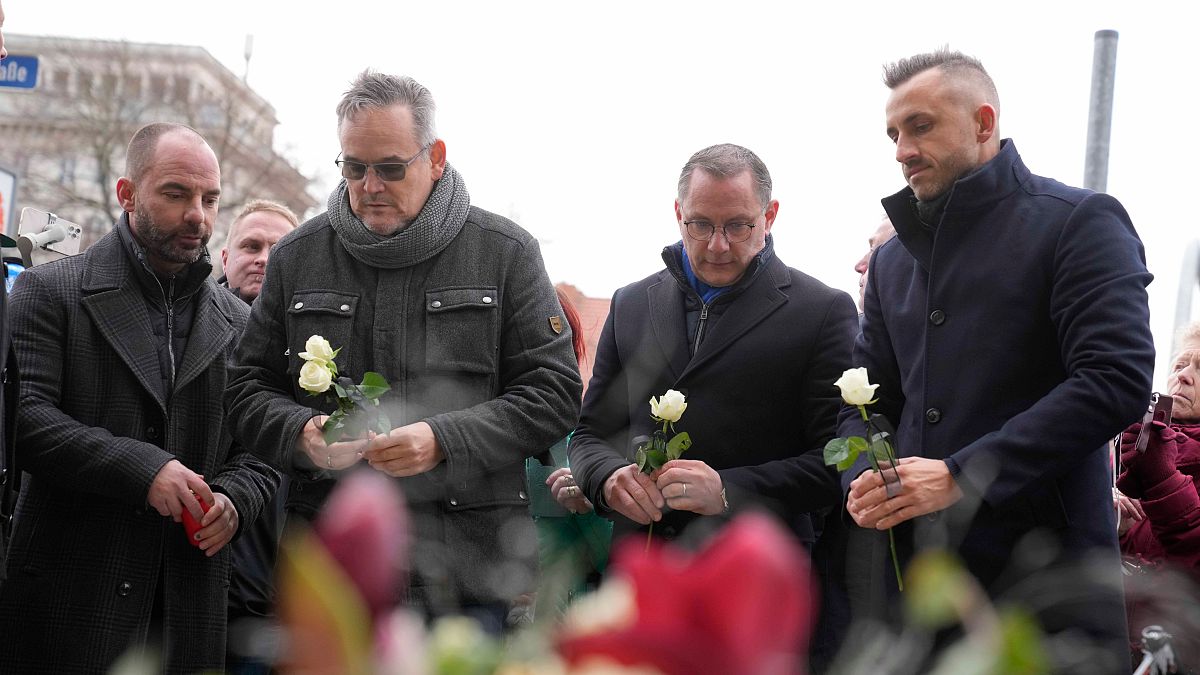World
‘Real hell’: Deadly fighting escalates in Sudan as truce expires

New outburst of violence in North Darfur state has left at least 40 people dead, activists and residents say.
Fighting intensified in Khartoum after a ceasefire deal expired and a new outburst of violence took hold in Sudan’s restive Darfur region with dozens reportedly killed in what was described as “complete lawlessness”.
Black smoke billowed above the capital on Sunday after the truce between Sudan’s army and the paramilitary Rapid Support Forces (RSF) expired hours earlier, live television footage showed.
“In southern Khartoum we are living in terror of violent bombardment, the sound of anti-aircraft guns and power cuts,” said 34-year-old resident Sara Hassan by phone. “We are in real hell.”
Fighting in the capital has led to widespread damage and looting, a collapse in health services, power and water cuts, and dwindling food supplies.
The RSF claimed it shot down a fighter jet after the army “launched an audacious airborne assault upon our forces’ positions” in northern Khartoum.
A military source said a Chinese-made jet crashed near Wadi Seidna base north of Khartoum because of a “technical malfunction”.
Witnesses said they saw an aircraft travelling from the south to the north of the capital with flames erupting from it. Others spoke of air strikes on RSF positions in the east of the city, with some civilian casualties reported.
Among the other areas where fighting was reported were central and southern Khartoum and Bahri, across the Blue Nile to the north.
Brokered by Saudi Arabia and the United States, the ceasefire calmed the street battles slightly and allowed limited humanitarian access, but like previous truces was repeatedly violated. Talks to extend the ceasefire broke down on Friday.
The deadly power struggle that erupted in Sudan on April 15 has triggered a major humanitarian crisis with more than 1.2 million people displaced within the country and another 400,000 fleeing into neighbouring states.
It also threatens to destabilise the region as a whole.
‘Completely out of control’
Beyond the capital, deadly fighting also broke out in the Darfur region in the far west of Sudan, already grappling with long-running unrest and huge humanitarian challenges.
Witnesses reported heavy fighting on Friday and Saturday had brought chaos to Kutum, one of the main towns and a commercial hub in North Darfur.
At least 40 people were killed and dozens more wounded, including residents of the Kassab camp which houses people displaced by earlier unrest, said the Darfur Bar Association, which monitors rights in the region.
The army denied claims that the RSF, which developed out of Darfur militias and has its power base in the region, had taken over Kutum.
Darfur Governor Mini Minawi – a former rebel leader now close to the army – on Twitter denounced “looting” by armed groups, declared Darfur a “disaster zone”, and appealed for help from the international community.
The governor of West Darfur, Khamis Abakar, said on Sunday there was “complete lawlessness” in his state. “Armed men have taken over everything, and the situation is completely out of control,” he said.
Saudi Arabia and the United States said they were continuing to engage daily with delegations from the army and the RSF, which had remained in Jeddah even though talks to extend the ceasefire were suspended last week.
“Those discussions are focused on facilitating humanitarian assistance and reaching agreement on near-term steps the parties must take before the Jeddah talks resume,” the two countries said in a statement.
RSF leader Mohamed Hamdan Dagalo, known as Hemedti, said in a Facebook post he had spoken by phone to the Saudi foreign minister to discuss Jeddah mediation efforts.
Hemedti’s whereabouts are unclear, although he appeared in video footage with his troops in central Khartoum earlier in the fighting.

World
Italian state railways plans 1.3 bln euro investment in solar plant

World
Christmas in Puerto Rico is a 45-day celebration with caroling, festive decorations, family feasts and more

Christmas, Navidad in Puerto Rico, extends far beyond Dec. 25.
The island proudly proclaims itself as having the “longest holiday season in the world,” according to the website Discover Puerto Rico.
On average, the holiday festivities in Puerto Rico last about 45 days, per the source, commencing right after Thanksgiving, and stretching all the way through mid-January.
The Christmas season in Puerto Rico typically lasts around 45 days. (iStock)
HOW TO SAY ‘MERRY CHRISTMAS’ IN 10 LANGUAGES TO FRIENDS AROUND THE WORLD
The holiday season in Puerto Rico is full of rich traditions beloved by families.
One tradition those who visit Puerto Rico will immediately notice during the holiday season is decorations.
In Puerto Rico, decorations are typically put up by Thanksgiving, and kept up until the season concludes in mid-January, with opportune picture moments at every corner.
Parrandas, Christmas caroling, is a holiday staple.
17 SECRET TRAVEL TIPS FOR FALL AND WINTER THAT AREN’T SO SECRET AFTER ALL
Carolers choose houses of family and friends to visit, typically starting around 10 p.m., performing aguinaldos (traditional Christmas songs), with not only their voices, but often with instruments as well, according to Discover Puerto Rico.
The group you begin caroling with is likely not the same group you end with.
In Puerto Rico, when carolers visit a house, they’ll often stop inside for conversation, food and drink before moving to the next residence.

Coquito is a popular beverage enjoyed during the holiday season in Puerto Rico. Coconut, vanilla and rum are among the ingredients. (Mayra Beltran/Houston Chronicle via Getty Images)
Usually, the residences of the house visited will join the group for the next house, according to Discover Puerto Rico.
CHRISTMAS TREES IN GERMANY WERE DECORATED WITH APPLES INSTEAD OF ORNAMENTS IN THE 1600S FOR ‘ADAM AND EVE DAY’
A night of serenading loved ones can last quite a while, often stretching into the early morning hours of the following day, according to the source.
The biggest day of the holiday season in Puerto Rico actually isn’t Christmas, but instead, the night before.
In Puerto Rico, Dec. 24 is Nochebuena. On that day, loved ones gather for the exchange of gifts, caroling and a large feast.
Many families will also attend a midnight Mass on the day, known as Misa de Gallo.
FLIGHT ATTENDANTS REVEAL THE SURPRISING DAY TO TRAVEL AHEAD OF THE CHRISTMAS RUSH
After Christmas passes, the festivities go on in Puerto Rico.
Another big event in the holiday lineup is Three Kings Day on Jan. 6, a holiday that “commemorates the visit that the Three Wise Men paid to Jesus after his birth,” according to Discover Puerto Rico.
On the eve of the day, children fill up a shoebox with grass to be left for camels to munch on while the Three Kings leave behind gifts for them, according to PuertoRico.com.
For a particularly festive Three Kings Day, Juana Díaz is the place to go, as it hosts the largest celebration in Puerto Rico for the holiday. In Juana Díaz, there is an annual festival and parade in honor of Three Kings Day that brings together over 25,000 people every year, according to Discover Puerto Rico.

Gifts are primarily exchanged between loved ones on Christmas Eve in Puerto Rico. (iStock)
Then, eight days later is Octavitas, a post-holiday celebration where families get together and celebrate one last time for the season.
The end of the holiday season is marked with the San Sebastián Street Festival.
This festival, spanning over multiple days, takes place in Old San Juan, and is filled with live music, dancing, shopping and parades.
World
Small plane crashes into Brazil town popular with tourists, killing 10

Twin-engine plane crashed in largely residential neighborhood of Gramado shortly after takeoff, authorities say.
A small plane has crashed into a tourist hotspot in southern Brazil, killing all 10 people on board and injuring more than a dozen people on the ground, officials have said.
The twin-engine Piper PA-42-1000 hit the chimney of a home and the second floor of a different house before crashing into a shop in a largely residential neighbourhood of Gramado shortly after takeoff from Canela, Brazil’s Civil Defense agency said on Sunday.
Rio Grande do Sul Governor Eduardo Leite told a news conference that the aircraft’s owner and pilot, Luiz Claudio Galeazzi, was killed along with nine members of his family.
Leite said that 17 people on the ground were injured, 12 of whom were still receiving treatment in hospital.
Galeazzi’s company, Galeazzi & Associados, confirmed that its CEO and Galeazzi’s wife and three daughters had died in the crash.
“Luiz Galeazzi will be forever remembered for his dedication to his family and for his remarkable career as a leader of Galeazzi & Associados,” the company said in a post on LinkedIn.
“In this moment of immense pain, Galeazzi & Associados is deeply grateful for the expressions of solidarity and affection received from friends, colleagues and the community. We also sympathize with all those affected by the accident in the region.”
Gramado, located in the Serra Gaucha mountains, is a popular destination for vacationers, especially during the Christmas season.
The crash comes a little more than a year after Brazil suffered its worst air disaster in nearly two decades when a twin-engine plane crashed in the southeastern city of Vinhedo, killing all 62 people on board.
-

 Politics1 week ago
Politics1 week agoCanadian premier threatens to cut off energy imports to US if Trump imposes tariff on country
-
/cdn.vox-cdn.com/uploads/chorus_asset/file/25789444/1258459915.jpg)
/cdn.vox-cdn.com/uploads/chorus_asset/file/25789444/1258459915.jpg) Technology1 week ago
Technology1 week agoOpenAI cofounder Ilya Sutskever says the way AI is built is about to change
-

 Politics1 week ago
Politics1 week agoU.S. Supreme Court will decide if oil industry may sue to block California's zero-emissions goal
-
/cdn.vox-cdn.com/uploads/chorus_asset/file/25546252/STK169_Mark_Zuckerburg_CVIRGINIA_D.jpg)
/cdn.vox-cdn.com/uploads/chorus_asset/file/25546252/STK169_Mark_Zuckerburg_CVIRGINIA_D.jpg) Technology1 week ago
Technology1 week agoMeta asks the US government to block OpenAI’s switch to a for-profit
-

 Business1 week ago
Business1 week agoFreddie Freeman's World Series walk-off grand slam baseball sells at auction for $1.56 million
-
/cdn.vox-cdn.com/uploads/chorus_asset/file/23951353/STK043_VRG_Illo_N_Barclay_3_Meta.jpg)
/cdn.vox-cdn.com/uploads/chorus_asset/file/23951353/STK043_VRG_Illo_N_Barclay_3_Meta.jpg) Technology1 week ago
Technology1 week agoMeta’s Instagram boss: who posted something matters more in the AI age
-
News1 week ago
East’s wintry mix could make travel dicey. And yes, that was a tornado in Calif.
-
/cdn.vox-cdn.com/uploads/chorus_asset/file/24924653/236780_Google_AntiTrust_Trial_Custom_Art_CVirginia__0003_1.png)
/cdn.vox-cdn.com/uploads/chorus_asset/file/24924653/236780_Google_AntiTrust_Trial_Custom_Art_CVirginia__0003_1.png) Technology2 days ago
Technology2 days agoGoogle’s counteroffer to the government trying to break it up is unbundling Android apps

















